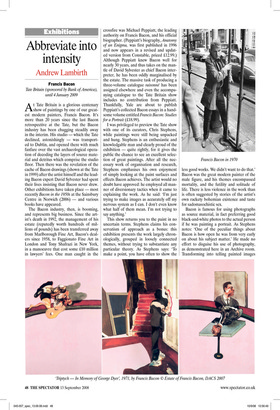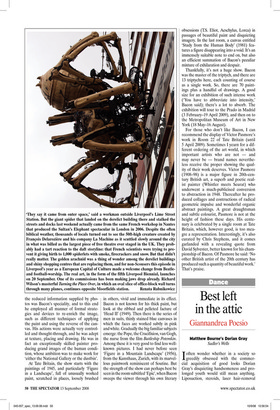Abbreviate into intensity
Andrew Lambirth
Francis Bacon Tate Britain (sponsored by Bank of America), until 4 January 2009 At Tate Britain is a glorious centenary show of paintings by one of our greatest modern painters, Francis Bacon. It’s more than 20 years since the last Bacon retrospective at the Tate, but the Bacon industry has been chugging steadily away in the interim. His studio — which the Tate declined, astonishingly — was transported to Dublin, and opened there with much fanfare over the vast archaeological operation of decoding the layers of source material and detritus which comprise the studio floor. Then there was the revelation of the cache of Bacon drawings (shown at the Tate in 1999) after the artist himself and the leading Bacon expert David Sylvester had spent their lives insisting that Bacon never drew. Other exhibitions have taken place — most recently Bacon in the 1950s at the Sainsbury Centre in Norwich (2006) — and various books have appeared.
The Bacon industry, then, is booming, and represents big business. Since the artist’s death in 1992, the management of his estate (reputedly worth hundreds of millions of pounds) has been transferred away from Marlborough Fine Art, Bacon’s dealers since 1958, to Faggionato Fine Art in London and Tony Shafrazi in New York, in a manoeuvre that cost some £10 million in lawyers’ fees. One man caught in the crossfire was Michael Peppiatt, the leading authority on Francis Bacon, and his official biographer. (Peppiatt’s biography, Anatomy of an Enigma, was first published in 1996 and now appears in a revised and updated version from Constable, priced £12.99.) Although Peppiatt knew Bacon well for nearly 30 years, and thus takes on the mantle of David Sylvester as chief Bacon interpreter, he has been oddly marginalised by the estate. The massive task of producing a three-volume catalogue raisonné has been assigned elsewhere and even the accompanying catalogue to the Tate Britain show includes no contribution from Peppiatt. Thankfully, Yale are about to publish Peppiatt’s collected Bacon essays in a handsome volume entitled Francis Bacon: Studies for a Portrait (£18.99).
I was privileged to preview the Tate show with one of its curators, Chris Stephens, while paintings were still being unpacked and hung. Stephens is an enthusiastic and knowledgable man and clearly proud of the exhibition — quite rightly, for it gives the public the chance to see an excellent selection of great paintings. After all the necessary work of organisation and research, Stephens emphasises his own enjoyment of simply looking at the paint surfaces and effects Bacon achieves. The artist would no doubt have approved: he employed all manner of diversionary tactics when it came to explaining the work. As he said: ‘I’m just trying to make images as accurately off my nervous system as I can. I don’t even know what half of them mean. I’m not trying to say anything.’ This show returns you to the paint in no uncertain terms. Stephens claims his conservatism of approach as a bonus: this exhibition presents the work largely chronologically, grouped in loosely connected themes, without trying to substantiate any particular theory. As Stephens says: ‘To make a point, you have often to show the less good works. We didn’t want to do that.’ Bacon was the great modern painter of the male figure, and his themes encompassed mortality, and the futility and solitude of life. There is less violence in the work than is often suggested by stories of the artist’s own rackety bohemian existence and taste for sadomasochistic sex.
Bacon is famous for using photographs as source material, in fact preferring good black-and-white photos to the actual person if he was painting a portrait. As Stephens notes: ‘One of the peculiar things about Bacon is how open he was from very early on about his subject matter.’ He made no effort to disguise his use of photography, as demonstrated here in an Archive room. Transforming into telling painted images the reduced information supplied by photos was Bacon’s speciality, and to this end he employed all manner of formal strategies and devices to re-enrich the image, such as different techniques of applying the paint and using the reverse of the canvas. His actions were actually very controlled and thought-through, and he was adept at texture, placing and drawing. He was in fact an exceptionally skilled painter producing grand images of the human condition, whose ambition was to make work for ‘either the National Gallery or the dustbin’.
At Tate Britain, the show starts with the paintings of 1945, and particularly ‘Figure in a Landscape’, full of unusually worked paint, scratched in places, loosely brushed in others, vivid and immediate in its effect. Bacon is not known for his thick paint, but look at the ribbed and pelleted facture of ‘Head II’ (1949). Then there is the series of men in suits, thinly stained blue canvases in which the faces are worked subtly in pink and white. Gradually the big familiar subjects emerge: the Pope, the Crucifixion, van Gogh, the nurse from the film Battleship Potemkin. Among these it is very good to find less wellknown pictures. I had never before seen ‘Figure in a Mountain Landscape’ (1956), from the Kunsthaus, Zurich, with its marvellous paintwork reminiscent of Soutine. But the strength of the show can perhaps best be seen in the room subtitled ‘Epic’, when Bacon sweeps the viewer through his own literary obsessions (T.S. Eliot, Aeschylus, Lorca) in passages of beautiful paint and disquieting imagery. In the last room, a canvas entitled ‘Study from the Human Body’ (1981) features a figure disappearing into a void. It’s an immensely suitable note to end on, but also an efficient summation of Bacon’s peculiar mixture of exhilaration and despair.
Thankfully, it’s not a huge show. Bacon was the master of the triptych, and there are 13 triptychs here, each counting of course as a single work. So, there are 70 paintings plus a handful of drawings. A good size for an exhibition of such intense work (‘You have to abbreviate into intensity,’ Bacon said); there’s a lot to absorb. The exhibition will tour to the Prado in Madrid (3 February–19 April 2009), and then on to the Metropolitan Museum of Art in New York (18 May–16 August).
For those who don’t like Bacon, I can recommend the display of Victor Pasmore’s work in Room 22 of Tate Britain (until 5 April 2009). Sometimes I yearn for a different ordering of the art world, in which important artists who are not — and may never be — brand names nevertheless receive the proper showing the quality of their work deserves. Victor Pasmore (1908–98) is a major figure in 20th-century British art, a superb and poetic realist painter (Whistler meets Seurat) who underwent a much-publicised conversion to abstraction in 1948. Thereafter he produced collages and contructions of radical geometric impulse and wonderful organic abstract paintings. A great draughtsman and subtle colourist, Pasmore is not at the height of fashion these days. His centenary is celebrated by a single room at Tate Britain, which, however good, is too meagre a representation. Interestingly, it’s also curated by Chris Stephens, and it comes garlanded with a revealing quote from David Sylvester, better known for his championship of Bacon. Of Pasmore he said: ‘No other British artist of the 20th century has produced such a quantity of beautiful work.’ That’s praise.











































































 Previous page
Previous page